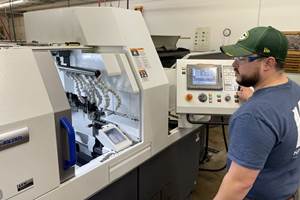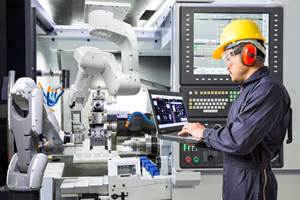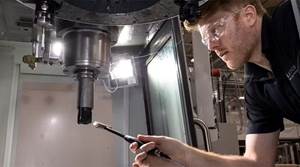Analyzing Sound Boosts Machine Monitoring
A new generation of sound analysis software detects, amplifies and records machine tool noises that can be analyzed for preventive and predictive maintenance.
Share





“I don’t like the sound of that.” That thought or expression can be an important part of being responsible for the performance of a machine tool. Sounds from the shop floor are now becoming an important part of how machines and processes can be monitored in the factory enabled by the Industrial Internet of Things (IIoT). A cutting tool that starts to chatter or make a squealing noise going into the corner of a pocket, or an unexpected clunk or tapping often indicate a less-than-optimal condition that calls for attention. A trained ear may detect even more subtle sounds that might be worrisome, such as the scraping of a ball in a ballscrew nut or spindle bearing. Recognizing that these audible clues indicate a specific response can prevent downtime or scrap.
A new generation of sound analysis software makes it possible to detect, amplify and record the noises as signals that can be digitized and acted upon. This data helps automate applications such as machine monitoring, preventive maintenance and predictive maintenance. One company, of Palo Alto, California, is taking the next steps to use the sounds in the factory for these and other purposes based on a software platform designed to turn machine sounds into actionable meaning.
OtoSense is a Silicon Valley startup that has its roots in research originally conceived as a way to help hearing-impaired children. The value of this research for industrial applications was quickly recognized by experts eager to promote IIoT opportunities in manufacturing. OtoSense was formed in 2014 and began serving the automotive, aerospace and general manufacturing fields.
According to the developers, the software platform offered by the company is distinguished from other concepts of sound and vibration monitoring by its ability to be quickly taught which anomalous sounds to detect and identify. If an identified sound requires action, this system can alert the appropriate responder. However, the software is able to go several steps beyond this ability, says Jags Kandasamy, chief product officer at OtoSense.
The software can “listen” to ambient noise in a factory or machine shop to detect a number of significant noises at once. It is not necessary to have a sensor or microphone “tuned” to a certain sound or specific source of sounds, Mr. Kandasamy says. For example, the software can record and map each new anomaly to be diagnosed as a symptom of an actionable event, which can then be monitored for a triggered response.
A factory can use the software to create a library or repository of sound profiles to create a structured semantic system to enable historical analysis, trend and search capabilities in the cloud. In other words, Mr. Kandasamy explains, the sound profile can be used the way a keyword can be used to search a database. The user’s database of sound recordings and profiles can be quite large, requiring Big Data analytics capability, Mr. Kandasamy says. The software can also apply complex logic to the analysis of sounds so their meaning can be interpreted in its context.
To set up the sound-monitoring system, the user begins with any machine in which events (a motion, response, mechanical or electrical action) generate stationary and non-stationary sounds or vibrations. The next step is to install any relevant sensor delivering a time series in relation with acoustic waves, such as an accelerometer, piezo-electric device, pressure gage or laser. Signals from the sensor, in turn, are delivered as raw input to an OtoSense-enabled “edge device.” This edge device may consist of a tablet or any microprocessor-based device located on the network but acting independently of central computing resources.
The OtoSense Enabled Cloud application links to this edge device to download appropriate sound recognition models, thereby making it able to perform local, real-time or offline event recognition and anomaly detection. The sounds picked up by the sensors can be sorted out as normal, abnormal or needing to be checked as unexpected.
According to Mr. Kandasamy, one of the most promising capabilities of this technology is the opportunity to link the occurrence of an anomalous sound with a downstream event. “A sound coming from a production machine could be associated with a part jamming in an assembly operation, giving us an insight into a cause and effect that would otherwise be difficult to make,” he says.
Related Content
4 Commonly Misapplied CNC Features
Misapplication of these important CNC features will result in wasted time, wasted or duplicated effort and/or wasted material.
Read MoreERP Provides Smooth Pathway to Data Security
With the CMMC data security standards looming, machine shops serving the defense industry can turn to ERP to keep business moving.
Read More6 Machine Shop Essentials to Stay Competitive
If you want to streamline production and be competitive in the industry, you will need far more than a standard three-axis CNC mill or two-axis CNC lathe and a few measuring tools.
Read MoreHow to Mitigate Chatter to Boost Machining Rates
There are usually better solutions to chatter than just reducing the feed rate. Through vibration analysis, the chatter problem can be solved, enabling much higher metal removal rates, better quality and longer tool life.
Read MoreRead Next
How I Made It: Dennis Rymanowski
Dennis Rymanowski has worked at NSH USA for 60 years, with his passion for manufacturing living alongside his passion for his family’s polka band.
Read MoreA New Frontier in Surface Finish Control
What if your machine tool could measure surface roughness as it cuts? This article explores how in-process metrology is advancing from concept to reality, enabling real-time feedback, immediate detection of anomalies and new levels of control over surface quality. Discover the technologies making this possible.
Read More


















